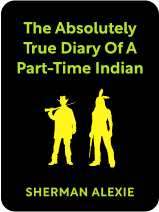

This article is an excerpt from the Shortform summary of "The Absolutely True Diary of a Part-Time Indian" by Sherman Alexie. Shortform has the world's best summaries of books you should be reading.
Like this article? Sign up for a free trial here .
What is the chapter “How to Fight Monsters” about in the book The Absolutely True Diary of a Part-Time Indian? What lessons does Junior learn in the chapter?
In The Absolutely True Diary of a Part-Time Indian, the chapter “How to Fight Monsters” details Junior’s first days at Reardan High School. Junior leaves the reservation in search of a better education, and details his struggles at Reardan to fit in, and the racism he encounters.
Keep reading for a summary of the chapter “How to Fight Monsters.”
How to Fight Monsters: Junior’s First Days at Reardan
In the chapter “How to Fight Monsters” Junior shows up for his first day at Reardan with a black eye and a swollen nose from Rowdy’s “good-bye punch.” Before Junior’s dad drops him off, he tells Junior to remember that the white kids are no better than he is. But they both know that’s not true. Junior knows that they both understand they’re Indians losers “living in a world built for winners.”
As Junior waits for the building to open, the other kids stare at him—he’s the only Indian at Reardan, aside from the school mascot. Once in class, Junior meets blonde, blue-eyed Penelope, the most beautiful girl he’s ever seen. As the teacher calls roll, Penelope asks Junior what his name is. When he tells her, she starts laughing and telling her friends, and Junior realizes that they’re laughing at his name. It’s never occurred to him that he has an unusual name. On the rez, if you walk into a store and call out for “Junior,” seventeen guys and three women will answer.
Things get worse for Junior when the teacher, still calling roll, calls him by his “name name,” Arnold Spirit. Penelope angrily turns back to him and accuses him of giving her a fake name. He tries to explain that his name is both Junior and Arnold, feeling, as he does, like two different people: On the rez, he’s Junior; in Reardan, he’s Arnold. In
Getting by at Reardan
(Shortform note: This section includes a quote from the book that uses the N-word. We’re using the word itself because this is a significant moment in Junior’s Reardan experience.)
In the chapter “How to Fight Monsters” Junior’s first days at Reardan are lonely. Most of his classmates ignore him. However, a few of the jocks pick on him. They never try to fight him—Junior suspects that even though he’s nerdy, he’s an Indian and, therefore, viewed as a “potential killer.” Instead of fighting him, they call him names like “Chief,” “Tonto,” and “Squaw Boy.”
Initially, Junior ignores them. He’s afraid that if he does get into a fight with these boys who are much bigger than he is, they’ll literally kill him. But this nonviolent attitude ceases when, one day, an older jock named Roger asks Junior if he wants to hear a joke: “Did you know that Indians are living proof that n*ggers fuck buffalo?”
Junior has never heard anything so racist. He feels the need to defend not only himself, but also black people, his fellow Indians, and buffalo. He punches Roger in the face.
Junior backs away and gets into position to continue the fight, but the group of jocks just stares at him, shocked. All Roger can say as the blood comes out of his nose is that he can’t believe that Junior has punched him.
Junior suddenly feels brave. He thinks maybe this is the pivotal moment in his life when he tells the world that he’s no longer willing to be a human punching bag. He tells Roger to meet him at the same spot after school so they can finish the fight, as per the fisticuff protocol on the rez, but Roger tells him he’s crazy, gets up, and walks away.
Junior’s bravery turns into confusion. He’s followed all the Spokane rules of fighting. So why are these boys ignoring him rather than defending their honor? Maybe the rules are different at Reardan? As Roger walks off, Junior calls after him and asks what the rules are. Roger, perplexed, responds, “What rules?” and continues to walk away.
Junior is now confused and terrified. He realizes that Reardan is like a different planet and he doesn’t know how to get back home.
The next morning, Junior’s dad’s best friend, Eugene, sees Junior walking to school and gives him a ride to school on his motorcycle. Roger sees them and approaches Junior after he gets off the bike. Junior’s scared, but to his surprise, Roger just compliments the bike and tells Junior that he’ll see him around. Junior realizes that he’s earned Roger’s respect by punching him.
Hoping to ride the wave of this good luck, Junior sees popular Penelope and says hello. She ignores him. When he says hello again, she sniffs, pretends she doesn’t know him, and then refers to him as the kid who doesn’t know his own name.
Petrified Wood
After the chapter “How to Fight Monsters” Junior continues to struggle at Reardan. Junior continues to feel like he’s split in two: He wakes up as an Indian (Junior) and arrives at Reardan as a nobody (Arnold). No one talks to him or even looks at him. He eats lunch by himself and plays catch with himself during P.E.
On the plus side, Junior discovers that he’s smarter than almost everyone in the school. For instance, one day in geology class, the teacher marvels at how amazing it is that wood can turn into rock. Junior raises his hand, for the first time ever at Reardan, to correct his teacher, telling him that petrified wood isn’t actually wood.
Junior’s classmates are shocked that he’s bold enough to contradict a teacher, and the teacher is angry and indignant, telling Junior that if he’s so smart, he should tell the class how it works. Junior does, explaining that minerals take the place of wood molecules, so there’s no wood left by the time it has become “petrified wood.”
The teacher doesn’t believe Junior and mocks his shoddy reservation education, but Gordy, the class genius, raises his hand to confirm that Junior is right. Even the teacher knows that if Gordy says petrified wood isn’t actually wood, he’s right. The teacher thanks Gordy for sharing this interesting fact, ignoring Junior completely. Meanwhile, Junior thinks longingly of the days when he was treated like a human being and his teacher told him he was smart and deserved the world.
After class, Junior thanks Gordy for sticking up for him, but Gordy says he was sticking up for science, not Junior.
That night, Junior rides the bus to the end of the rez, where the line stops. As usual, he waits exactly thirty minutes for his father to pick him up, and when his father doesn’t show, Junior starts walking home. Often, Junior’s able to hitch a ride with someone, but three times, he’s had to walk the full 22 miles from the bus stop home.
“How to Fight Monsters” shows the struggles Junior faces when he starts school at Reardan. Despite these struggles, Junior hopes that things will get better.

———End of Preview———
Like what you just read? Read the rest of the world's best summary of Sherman Alexie's "The Absolutely True Diary of a Part-Time Indian" at Shortform .
Here's what you'll find in our full The Absolutely True Diary of a Part-Time Indian summary :
- How Junior gets split between two worlds when he goes to a mostly white school
- How Junior overcomes being an outsider to being part of welcoming social circles
- The tragedies of alcoholism and poverty that leave Junior with renewed strength






